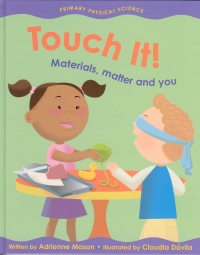| ________________
CM . . .
. Volume XII Number 7 . . . .November 25, 2005
We live in a material world. Every human-made object within our reach or line of vision is made from one or two or three or more materials. What might these materials be? What are the properties of each material? How do a material’s properties make it better for some uses than others? These are the big ideas that often are used to introduce chemistry to young children. They are embedded in the outcomes of Manitoba’s Grade 1 science cluster, “Characteristics of Objects and Materials,” and they are the framework that organizes Adrienne Mason’s book, Touch It! Materials, Matter and You. Mason begins with a list of materials, “Stone, metal, paper, plastic.” She tells children, “Everything around you is made of some kind of material” and provides two examples – “A marble is made of glass, and this book is made of paper.” This is followed by a question that can only be answered by looking carefully at illustrator Claudia Dávila’s two-page depiction of five children playing in a park-like playground as an older woman, sitting on a bench, knits and pays no attention to a bird that is removing a straw-like material from the decoration on her hat. Children who have played marbles, slid down a slide, and built sand structures in a sandbox using child-sized shovels and rakes and pails may be able to tell you that the slide and legs of the park bench are made from metal, the sandbox and park bench are made of wood, the pail and tools are plastic, and the trash bin is metal and lined with a bag made of plastic. It’s not possible, however, to know this from the illustration, just as it’s not possible to know if the clothing is woven or knit and made out of cotton, wool, linen, or a synthetic. There simply is not enough detail. This is a problem throughout the book. On pages 8 and 9, children are told, “You can use your senses of sight, touch, smell, and even taste to describe materials,” but, if one has never held and eaten a strawberry and a pineapple, it’s going to be difficult to compare these two foods, as readers are asked to do, using the illustration alone. Similarly, children are invited to describe the “kinds of textures” they see in an illustration on pages 10 and 11 of farmyard objects (water pail, water trough, pitch fork, saddle, bridle, seed, hay, and fence put together with bolts) and farmyard animals (chickens, rooster, sheep, cow, horse, rabbit, and porcupine). The sheep’s wool is made to look like balls of cotton, and there is no indication of hair on the cow, porcupine, rabbit, or horse, or quills on the porcupine, or feathers on the chickens. Without the real materials in hand, I’m not certain how useful this exercise will be if the goal is to recognize and understand that materials have particular textures that can be determined using the sense of touch. The next 16 pages of the book include descriptions of the scientific properties of mass, buoyancy (ability to float or sink on water), magnetic, and stretchy. Each description is followed by an activity that aims to make the property a reality for the child. As one example, when children have been told, “Mass is the amount of stuff in a object,” they are asked to determine if objects of the same size have the same mass. This is accomplished by putting together a simple balance scale made from an eraser, ruler, and two cups and using it to compare a metal coin and a plastic button of the same size. Touch It! concludes with two summary statements, “Objects are made of different materials” and “Certain materials are better for certain uses.” This is followed with two pages of very good science content information and teaching suggestions for parents and teachers, and an index and definitions of four “Words to Know” (magnetic, material, mass, and texture). Regardless of the difficulty associated with illustrating properties that can’t be determined using the sense of sight alone, Touch It! Materials, Matter and You is certain to be a book that is welcomed by many teachers, librarians, and parents. Unlike the life, earth and space sciences, there are not many books for young children that focus upon phenomena in physics and chemistry. Author, Adrienne Mason and illustrator, Claudia Dávila are certainly helping to fill a void. Kids Can Press should be congratulated for initiating the “Primary Physical Science Series” with the release of “Touch It!” and “Move It! Motion, Forces and You,” a Mason-Dávila collaboration also reviewed in this issue. Recommended. Barbara McMillan is a professor of early and middle years science education in the Faculty of Education, the University of Manitoba.
To comment
on this title or this review, send mail to cm@umanitoba.ca.
Copyright © the Manitoba Library Association. Reproduction for personal
use is permitted only if this copyright notice is maintained. Any
other reproduction is prohibited without permission.
NEXT REVIEW |
TABLE OF CONTENTS FOR THIS ISSUE
- November 25, 2005.
AUTHORS |
TITLES |
MEDIA REVIEWS |
PROFILES |
BACK ISSUES |
SEARCH |
CMARCHIVE |
HOME |
